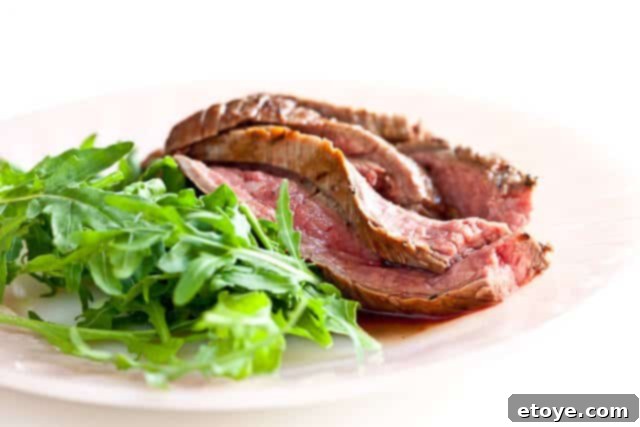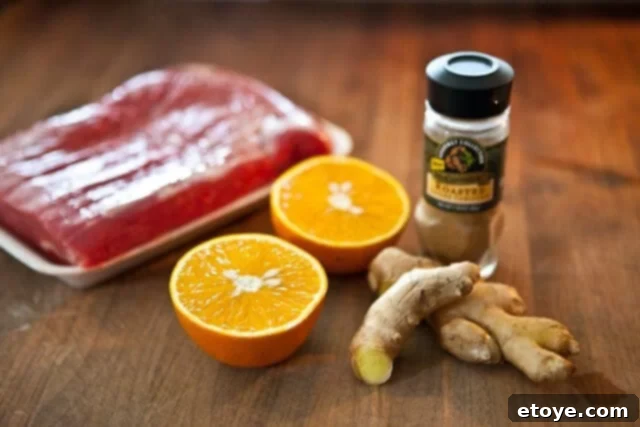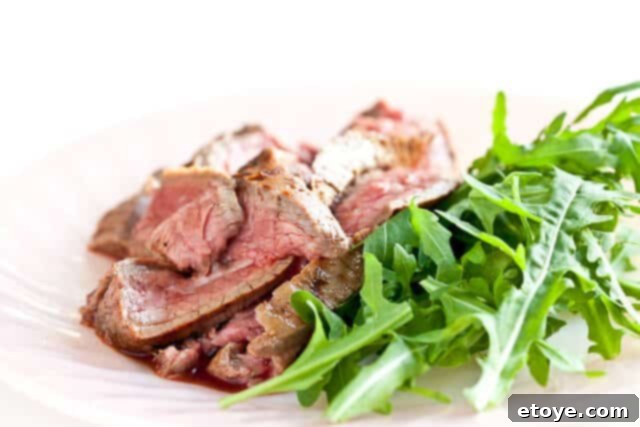
The Ultimate Guide to Perfectly Grilled Orange Ginger Flank Steak
Flank steak has steadily risen through the ranks to become one of the most beloved cuts for grilling enthusiasts and home cooks alike. For a long time, my go-to for flatter cuts destined for tacos, fajitas, or a simple grill was skirt steak. Its rapid rise in popularity, however, led to an unfortunate surge in price and occasional shortages at my local market. This turn of events prompted me to explore flank steak more regularly, and what a delightful discovery it has been!
Often overlooked, flank steak offers an incredible combination of robust, beefy flavor and surprising tenderness, provided it’s prepared correctly. When thinly sliced against the grain, it transforms into succulent ribbons that rival the tenderness of a good filet mignon, but with a much more pronounced and satisfying beef flavor. It’s a versatile and economical choice that deserves a prime spot in your culinary repertoire, perfect for weeknight dinners or impressive weekend barbecues.
Why Flank Steak Deserves a Spot on Your Grill
Flank steak, a lean cut from the abdominal muscles of the cow, is a powerhouse of flavor. Its distinctive grain and leanness mean it benefits immensely from a good marinade and high-heat cooking. Unlike some other cuts, flank steak doesn’t rely on marbling for tenderness. Instead, its texture is all about how it’s handled after cooking. This makes it an exciting challenge for cooks looking to perfect their grilling technique.
Many initially shy away from flank steak, fearing it might be tough. However, this is a common misconception stemming from improper preparation. With the right techniques – particularly a flavorful marinade to break down muscle fibers and precise slicing – flank steak delivers a dining experience that is both sophisticated and incredibly satisfying. It’s also remarkably versatile, serving as a fantastic base for a myriad of global cuisines, from Asian stir-fries to classic South American churrasco.
Crafting the Perfect Orange Ginger Marinade
The secret to an exceptionally tender and flavorful flank steak lies in an effective marinade. Our Asian-inspired Orange Ginger Marinade is a vibrant concoction that not only infuses the meat with incredible taste but also aids in tenderization. Each ingredient plays a crucial role in creating a balanced and aromatic profile:
- Freshly Squeezed Orange Juice: This isn’t just for flavor; the acidity from the orange juice acts as a natural tenderizer, gently breaking down the muscle fibers and ensuring a more succulent bite. It also imparts a bright, tangy citrus note that beautifully complements the richness of the beef. Always opt for fresh juice over bottled for the best flavor and acidity.
- Grated Fresh Ginger: The pungent, slightly spicy “zing” of fresh ginger is a cornerstone of Asian cuisine. It adds an invigorating warmth and a complex aromatic depth that elevates the entire dish. Freshly grated ginger releases its essential oils more effectively than dried, making a significant difference in the final flavor.
- Ground Coriander: This often-underestimated spice brings a warm, earthy, and subtly lemony note to the marinade. It acts as a bridge between the bright citrus and the pungent ginger, creating a harmonious blend of flavors. We’ll delve deeper into the wonders of coriander shortly.
- Olive Oil: Essential for carrying the fat-soluble flavors of the marinade into the meat and helping to create a beautiful crust during grilling.
- Sea Salt and Freshly Ground Black Pepper: Fundamental seasonings that enhance the natural flavors of the beef and balance the marinade. Salt also aids in the tenderization process by helping the meat retain moisture.
Allowing the flank steak to marinate for at least four hours, or ideally overnight, is key. This extended period ensures that the flavors fully penetrate the meat and the tenderizing agents have ample time to work their magic.

Mastering the Grill: Tips for Flank Steak Perfection
Achieving the perfect medium-rare flank steak involves a few key techniques that can make all the difference. While many cooks advocate for letting steak come to room temperature before grilling, thin cuts like flank steak (and skirt steak) actually benefit from being grilled straight from the refrigerator.
Temperature Control for Thin Cuts
For thinner cuts, starting with a colder steak allows for more precise temperature control. The outside gets a fantastic sear on a hot grill before the center overcooks, making it easier to hit that elusive medium-rare without charring the exterior. This method helps prevent the steak from cooking through too quickly, giving you a wider window to achieve your desired doneness.
The Art of High-Heat Grilling
Flank steak thrives on high, direct heat. Preheat your grill until it’s screaming hot. This intense heat is crucial for creating a delicious, caramelized crust (the Maillard reaction) that locks in juices and adds another layer of flavor. Grill the marinated flank steak for just 3-5 minutes per side, depending on its thickness, for a beautiful medium-rare.
Resting is Non-Negotiable
Once your steak is cooked, resist the urge to slice into it immediately. Transfer the flank steak to a cutting board and let it rest for at least 10 minutes. This resting period allows the juices, which have been driven to the center of the meat by the heat, to redistribute evenly throughout the steak. The result is a far juicier and more tender piece of meat.

The Golden Rule: Slicing Against the Grain
This is perhaps the single most critical step for ensuring tender flank steak. Flank steak has long, visible muscle fibers, which are its “grain.” If you slice with the grain, you’ll end up with chewy, stringy, and tough meat, regardless of how perfectly it was cooked. To achieve maximum tenderness, you must slice *across* the grain, perpendicular to these fibers.
Look closely at your cooked flank steak. You’ll see the fibers running in a particular direction (e.g., from left to right in the adjacent image). Your knife cuts should go against that direction. By cutting across the grain, you shorten those muscle fibers, making each bite much easier to chew and more enjoyable. Use a sharp chef’s knife and slice at a slight angle for wider, more elegant ribbons.
Serving with Style and Ease
For convenience and impressive presentation, I always recommend slicing flank steak before serving, especially when entertaining guests. This not only ensures everyone gets perfectly tender pieces but also saves your guests from having to navigate slicing tough meat at the table. Thin, pre-sliced ribbons are also ideal for serving with simple sides like brown rice and a fresh green salad, making a complete and satisfying meal.

Orange Ginger Flank Steak Marinade – A Flavorful Foundation


Spotlight on Spice: The Allure of Coriander
In our quest for culinary excellence, understanding the spices we use is paramount. Ground coriander, a star in our marinade, offers a nuanced flavor profile that truly enhances the beef. As highlighted by McCormick Gourmet, coriander seed, a spice of ancient origins, is often described as having a slight lemon flavor, making it incredibly versatile for both sweet and savory dishes.
Botanically Speaking
Coriander is derived from the dried, ripe fruit of the herb Coriandum sativum. This same plant also yields leaves known as cilantro, though their flavors are distinctly different. The tannish-brown seeds of coriander offer a subtle note of citrus, often with hints of sage in the background. It’s available in both whole seed and ground forms, each offering a slightly different intensity to dishes.
Yum Factor
Highly valued for both its aroma and unique flavor, coriander seeds are a culinary chameleon. They impart a delightful lemony zest to European pastries, sweet breads, and cakes, demonstrating their sweet-side versatility. On the savory side, this same profile adds a citrusy flair to robust Southeast Asian and North African spice blends such as Indian garam masala and Ethiopian berbere. A gentle dusting can brighten simply steamed or buttered vegetables, and it’s a fantastic addition to vegetable and chicken soups, as well as homemade curry and chili powders.
Globetrotter’s Guide
While coriander is indigenous to Southern Europe and the Mediterranean region, its cultivation has spread globally. Today, Canada stands as a primary source for this widely used spice, a testament to its adaptability and universal appeal.
Believe It…Or Not
Beyond its culinary applications, coriander boasts a rich history. Ancient Greeks and Romans reportedly used coriander in attempts to create love potions. However, it was the captivating fragrance of this “Persian delight” that drew visitors to the legendary Hanging Gardens of Babylon as far back as 600 B.C. As civilizations expanded, so did coriander’s popularity, not just as a condiment but also as a medicinal ingredient. It made its way to the Americas, introduced in Massachusetts in 1670, becoming one of the first herbs cultivated by early colonists.

Orange Ginger Flank Steak Recipe
Ingredients
- 1 orange, juiced
- 1 teaspoon grated fresh ginger
- 1 tablespoon olive oil
- 1 teaspoon ground coriander
- sea salt (I used 1 1/2 teaspoons sea salt)
- freshly ground black pepper
- 2 pounds flank steak
Instructions
- In a large resealable bag, add all of the ingredients. Squeeze out all of the air and seal. Refrigerate for 4 hours or overnight.
- When ready to cook, preheat grill on high heat. Grill the flank steak (discard the marinade) 3-5 minutes each side, depending on thickness. Let rest of cutting board for 10 minutes.
- Slice across the grain into thin slices and serve immediately.
Serving Suggestions and Delicious Variations
While our Orange Ginger Flank Steak is delicious on its own, it truly shines when paired with the right accompaniments. A simple green salad dressed with a light vinaigrette and fluffy brown rice makes for a classic, healthy, and satisfying meal that allows the steak to be the star. The neutrality of the rice soaks up any delicious juices, while the crisp salad provides a refreshing counterpoint.
For those looking to expand their culinary horizons, consider other serving ideas:
- Roasted Vegetables: Asparagus, bell peppers, or broccoli tossed with a little olive oil, salt, and pepper make excellent roasted sides that complement the steak’s flavors.
- Quinoa or Couscous: These grain alternatives offer different textures and can be easily flavored with herbs or a squeeze of lemon.
- Asian Noodle Salad: For a more complete Asian theme, serve the sliced steak atop a bed of cold soba noodles with a sesame-ginger dressing and fresh vegetables.
- Tacos or Fajitas: Leftover flank steak (or even freshly grilled) is perfect for elevating your taco or fajita night. Slice it into thinner strips and load up your tortillas with your favorite toppings.
- Steak Salad: Cool slices of flank steak are fantastic in a hearty salad with mixed greens, cherry tomatoes, cucumbers, and a zesty dressing.
The versatility of this dish means you can easily adapt it to suit your preferences and what you have on hand, ensuring that no two meals are ever exactly the same.
Conclusion: Embrace the Flavorful Journey of Flank Steak
Flank steak, with its robust flavor and ability to transform into a tender delight through careful preparation, is truly a cut above. This Orange Ginger Flank Steak recipe offers a simple yet sophisticated way to enjoy this fantastic cut, blending vibrant citrus and warm spices into an unforgettable meal. By understanding the nuances of marinating, grilling, and especially slicing against the grain, you unlock the full potential of this economical and delicious steak.
So, next time you’re at the butcher or grocery store, don’t overlook the flank steak. Give this recipe a try, and prepare to be amazed by the depth of flavor and tenderness you can achieve. It’s a culinary journey that promises delicious rewards and a newfound appreciation for one of the grill’s best-kept secrets.
